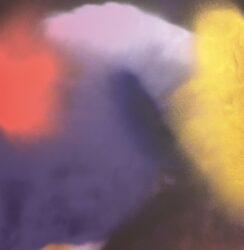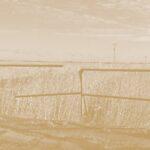SIMON SCOTT – LONG DROVE
I initially thought Long Drove was a linguistic twist of a ‘long drive’, and wondered what this past tense might exactly mean musically. But it turned out to be a reference to a location near where Simon Scott lives: the connective pathway between two nature reserves called Holme Fen and New Decoy.
So, Long Drove is ‘a site-specific sound study which shifts the Anthropocene discourse from spectatorship to musical participation, accountability, and creative engagement.’
‘One can almost hear Scott’s thought processes within these five compositions, of what the Fens would sound like if submerged and flooded by water again, returning to its original marshland state as a result of climate change, as the field recordings dissipate and unfurl with melancholic washes of decaying tape loops and digitally processed textures of Fenland sonorities.’
Ambient music often has a close connection to landscapes – whether imaginary or not – who isn’t yet familiar with Brian Eno’s Ambient 4 (On Land) should immediately check it out. Simon Scott’s interpretation of the surroundings is sounding a lot more urgent than Eno’s sonic landscape though. After all, we’re 40 years on from then – many years of increasing climate changes and impending disasters.
But the impending doom of climate change is not the main subject here: it is all about the combination of different sonic characteristics within the same location: ‘each season I’d return to observe the sonorities of wildlife merge and coalesce with the hum of the long telephone wires that stretch across the wide and flat Fens.’
The ‘connective pathway’ of Long Drove thus also connects the (manipulated) field recordings with Simon Scott’s modular synth system ‘to gradually tease out submerged hidden melodies.’
MARTINA BERTONI – HYPNAGOGIA 
Martina Bertoni only recently began releasing music under her own name (2 EP’s in 2018 and 2019, and the albums All The Ghosts Are Gone and Music For Empty Flats (both released in 2020). But long before that, she participated with Teho Teardo in Modern Institute, who released Excellent Swimmer way back in 2006.
As a cellist, her work ‘is based on deconstructing the relationship with her own instrument by combining acoustic sound, repetition, electronics and elements of improvisation.’ The cello may be the sound source, but its sound is heavily ‘processed, adding reverb, feedback and sub-bass frequencies and thus creating sonic sculptures, rich of atmospheres and frictions.’
Hypnagogia refers to ‘a transitional state of consciousness from wakefulness to sleep, during which one
might experience sensorial hallucinations and lucid dreaming, and can tap into the pristine structures of the subconscious.
A perfect description too for the soundscapes Bertoni creates on the album with the same name. The tracks were partially inspired by Stanislaw Lem’s book Solaris. Everyone that has read that book, or has seen the classic film adaptation by Tarkovski will easily recreate the atmosphere while listening to this highly cinematic music.





